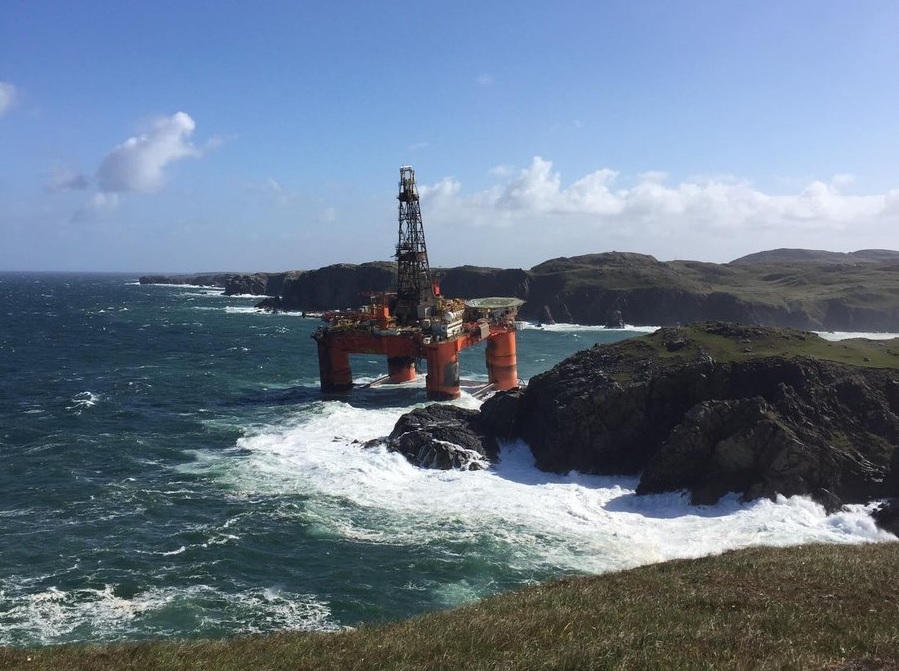The Transocean Winner oil rig which ran aground in the Outer Hebrides during severe storms early Monday morning is now being closely monitored by a counter-pollution team.
For the time being it appears as though there has been no substantial environmental damage by the rig, which has 280 tonnes of diesel on board, nobody was on the rig when it grounded, and the risk of pollution is low, say authorities.
So while things could be a lot worse, the situation is far from ideal, and it has led many to ask: why did it happen and how can we prevent a more dangerous situation from occurring in the future?
‘Worst August Winds’
According to media reports the oil rig was travelling from Norway to Malta, where it would then make its way to a yard in Turkey to be scrapped.
However, during what has been described by weather forecasters as “the worst August winds on record” the 17,000-tonne drilling rig became detached from a tug boat during the early hours of Monday, 8 August, and ran aground at Dalmore beach on the Isle of Lewis.
The beach is a known local surfing spot and as Angus MacLeod, chairman of Carloway Community Council, told BBC Alba: “There are a lot of people around here whose livelihoods are dependent on fishing, fish farming, and tourism … The community here is within a matter of yards from the shore.”
“If that had happened to be a loaded oil tanker the place would have been devastated,” he added.
It’s expected that the rig will be held in place by three to four tug boats until the next high tide when it can be re-floated out.
Richard Dixon, Director of Friends of the Earth Scotland, explained: “We understand that the next really high tide isn’t for about 10 days, and I’ve been told by the Scottish Environment Protection Agency that it may well be several weeks before the rig is re-floated.
“So clearly there is potential for a problem during that time particularly if there’s another storm … So if it were pounded by another big storm there could be a problem but otherwise if it’s ok just now, which is what those who went for a look said, then it’s probably unlikely that it’ll start leaking.”
Lessons to Learn
The event raises a lot of questions however, Dixon added, stating that answering them will be crucial to preventing future disasters.
Because the rig washed onto Dalmore beach on the west coast of Lewis, this indicates the rig was being towed along the ‘deep water’ shipping route, as opposed to between the Western Isles and the mainland (known as the Minches route).
“Why was it where it was when there was a storm coming is the key question to ask,” Dixon said.
“Why was it where it was, why was it still under tow, and why was it in the most dangerous spot, i.e. outside the mainland… when there was a major storm forecast?
“Why was it not anchored somewhere safely, or why was it not coming through the Minches? So [there’s] certainly something to learn from that.”
Another minor question Dixon added, is the issue of why almost 300 tonnes of diesel was sitting on a rig that was set to be scrapped: “Why was that not taken off in Norway if this was not actually an operational platform anymore? … Why is it dangerous when it could have been made safe before transport?”
Emergency Towing Vessels
Scottish MPs have also re-issued calls for an emergency towing vessel (ETV) to be reinstated in the area – an issue brought up recently in debates this past February.
Following the 1993 Braer oil spill disaster off the Shetlands, an inquiry led by Lord Donaldson recommended that ETVs be stationed around the UK’s coasts to protect the environment.
Until 2012 Scotland had two boats available to coastguard the north and west coasts. But at the end of 2011 the government limited this to a single ship in an effort to cut costs, thereby removing the one in Stornoway.
This meant that when the tow boat lost the Transocean Winner rig to the storm this week, the nearest ETV was sent to the scene from Northern Scotland. According to SNP MSP Alasdair Allan, the vessel was “in the region of 14 hours away”.
SNP MP Angus MacNeil, who has previously campaigned on the issue, told Sky News: “This could have been a very different outcome, and it is another example of why we need to have an emergency towing vessel on the west coast of Scotland.
“The UK Government must return the ETV to Stornoway – a tug is an insurance policy for an unusual but possible event.”
As Dixon of Friends of the Earth warned: “Had this been a tanker that was under tow and had gone aground, we could easily be looking at a very large spill rather than something that’s a bit safer.”
“I would hope this has been the wake up call to make sure we have that extra vessel so that should something else go wrong we’ve got something that can get out pretty quickly.”
Photo: Mark Macleod via Twitter
Subscribe to our newsletter
Stay up to date with DeSmog news and alerts







